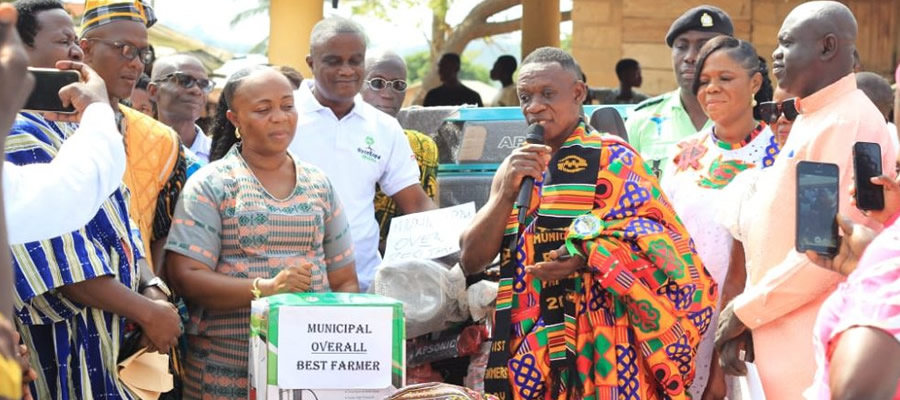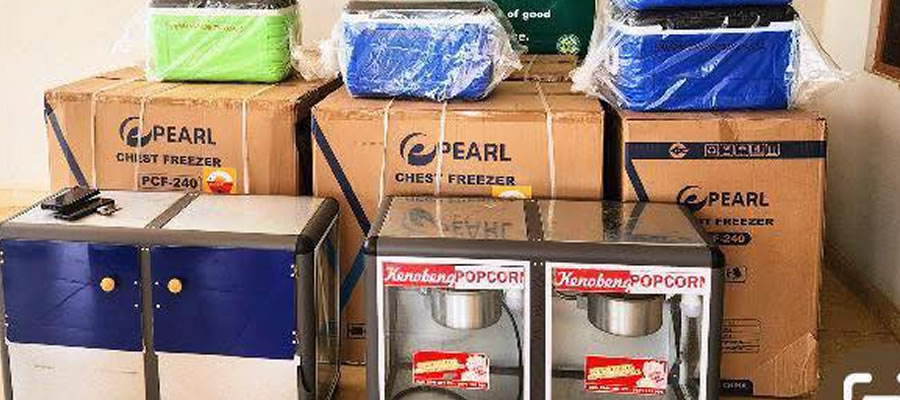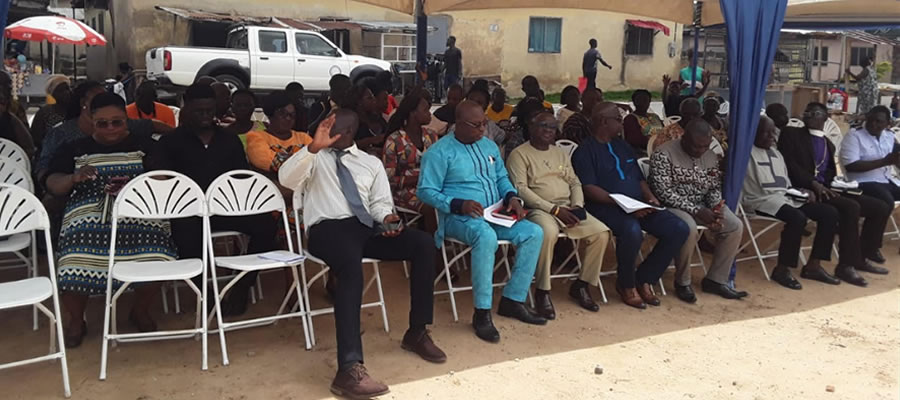

PHYSICAL AND NATURAL ENVIRONMENT
Location and Size
The New Juaben North Municipal is located within the South- East part of the Eastern Region of Ghana. The municipal shares boundaries to the North by Abuakwa North, to the South by New Juaben, to the East by Yilo Krobo, to the West by Suhum. It stretches between Latitude 60°70’W and Longitude 10°30’’ and 00°30’E. The municipal area has a total land area of 106 square kilometers.
Climate
The municipality falls within the semi-deciduous rain forest climatic zone with a bi-modal rainy season. The major rainy season is in April to July/August while the minor season is between September to November. The dry season is relatively short and is experienced between November/December and February. Humidity and temperatures are generally high ranging between 20°C and 32°C.
Geology and Minerals
The underlying rock formation in the municipal is mainly the Pre-Cambrian Rocks known as the Akuapem-Togo Series. These consists generally of partly metamorphic rocks, mainly made up 50 of Phyllites, Schists, and Quartzite with minor presence of unaltered Shale and Sandstones, Quartzite, Quartz-Schists, Serictic-Quartz Schists, Sericite Schists and Phyllites are the predominant rocks in the area though some quantities of Hornstones, Jasper and Hematite Quartz-Schists are also available, this rock formation has given rise to the presence of a number of quarries producing chippings for road and housing construction. These are mainly sited around the capital.
Relief and Drainage
The land in the municipality is generally undulating with heights ranging between 152m and 198m above sea level. Underlying these rock formations is mainly the Pre-Cambrian Rocks known as the Akuapem-Togo ranges. Others are Quartzite with minor presence of unaltered Shale and Sandstones. This rock formation has given rise to the presence of a number of quarries producing chippings for road and housing construction. These are mainly sited around Asokore.
The municipality is well drained with several rivers such as river Densu and its tributaries – Okome, Adane, Amosaw, Kyeramon, Bediase, Obomso, Totem etc. The Densu River is dammed at the Densuagya where the water is treated and distributed. Human activities such as estate development, improper waste disposal into some streams have contributed to the near extinction of some of these streams.
Encroachments of natural reserves have impacted negatively on these streams even threaten their extinction. This has led to flooding problems that perennially confront most of the towns in the municipal.
Soils and Soil Capability (Suitability for Agriculture)
Soils types in the municipal can be classified into three groups. These are;
- Nankese-Koforidua/Nta-Ofin Compound
- Fete-Bediesi Complex
- Adawso-Bawjiasi/Nta-Ofin Compound Association
The Nankese-Koforidua/Nta-Ofin Compound Association forms the bulk soil type. This compound association occurs in the extreme north of the Densu Basin. It consists of Koforidua-Nankese simple association and the Nta-Ofin simple association. The former is developed over well foliated biotite granodiorites while the latter consists of transported weathering products of the former. Included in the compound association are areas of soils developed over hornblende, granite and coarse grained diorite.
Koforidua series comprise soils with medium sandy loam humus topsoil that overlies a reddish brown quartz and ironstone gravel. Nankese series are the brown sub-soiled associate of Koforidua series. Nta soils are developed in the transported medium to coarse sands occurring in the upper and middle parts of drainage grooves and on the lower slopes of small valleys. Ofin soils are developed over grey alluvial sand a few metres in thickness which overlies a varying amount of stream and decomposing bedrock. (Source: NJSMA MTDP 2018-2021).
The soils in the Nankese-Koforidua Association are well suited for perennial tree crops and the adapted annual and semi-perennial food crops of the area. These soils are excellent media for the 51 growth of cocoa, oil palm, coffee and citrus. If the vegetation of the upland soil are cleared for crop production they are to be protected against erosion. The topsoil becomes dry during the dry season and therefore measures to conserve soil moisture should be adopted.
Nat series comprise droughty soils unsuitable for perennial tree crops except where the rainfall is abundant and more or less evenly distributed throughout the year. The Ofin Series on the other hand are suitable for growing dry season vegetables, sweet potatoes, sugar cane and rice since these soils are waterlogged and often flooded during the wet season, but may dry out almost completely during periods of drought or little rain.
Soils in the Fete-Bediesi Complex consist of Fete-Krabo Simple Association and Bediesi-Bejna Simple Association. The latter association occurs over the Voltarian Rocks from the extreme north of the Densu Basin to just west and north east of Koforidua. The Fete Series comprise excessively drained pale brown brashly soils developed on steep slopes over quartzite and sandstone of Togo Range. These soils normally dry out quickly on exposed cultivated plots, becoming droughty during dry periods. Rocky outcrops are frequent but they do not interfere much with land cultivation.
These soils are most economically utilized for the production of annual and semi-perennial food crops. They are relatively well supplied with potash, lime and magnesia but are likely to be low in readily available phosphorus. Plantain and cocoyam are widely grown on these soils.
Table 1.13: Gives a summary of the soil characteristics, crops and their suitability for agriculture
Table 1.13: Soil Characteristics Soil Classification Characteristics
Rainfall
The Municipal lies within Semi-equatorial climate zone with a double maxima rainfall regime- The maximum rainfall period coincides with the farming season. These help agricultural activities in the Municipal. The distribution of rainfall is very important for agriculture. Table 1.15 below shows rainfall partern within the municipal from 2014-2017.
Vegetation
The New Juaben North Municipal falls within one of the three agro-climatic zones of the country, namely the semi-deciduous rain forest- The semi-deciduous forest zone is mainly the Celtic-Triplochiton Associates of Taylor (1952). Remnant species of these associates indicate that it covered about 85 percent of the total area from the extreme north near Tafo proceeding southward. Here the vegetation is mainly characterized by tall trees with evergreen undergrowth and used to be abundant with economic trees. Scattered patches of secondary or broken forest are present under most of the larger trees among which are Triplochitonscleroxylon (Wawa), Antaris Africana (Kyenkyen), Chlorophora excels (Odum), Ceibapentandra (Onyina) are now few occurring as scattered emergent. Farming, lumbering and building activities have led to the cutting down of much of the original vegetation.
The flora and fauna is diverse and composed of different spears of economic and ornamental tree species with varying heights, game and wildlife. The effective and appropriate utilization of the natural resources through the support from the forestry commission to ensure rightful use of the economic and financial resources can help spearhead the Municipal development at a fast pace.
1.8.8. Implication for Development – Physical and Natural Environment The unique and strategic location of the municipal offers it access to the national capital. Tourists and holiday makers are also attracted to the municipal.
However, there is a negative development where some of these tourists and holiday makers have a negative influence on youth and increasing prevalence of HIV/AIDs. The climatic condition in the Municipal is suitable for the cultivation of food crops such as oil palm, maize, cocoyam, yam, plantain, cassava, and all kinds of vegetables. The erratic and unpredictable nature of the rainfall pattern in recent times has adverse implications for the rain fed agriculture being practiced.
BIODIVERSITY, CLIMATE CHANGE, GREEN ECONOMY AND ENVIRONMENT IN GENERAL
Climate change has become one of the biggest challenges of this century, and as a global challenge it requires global solutions. Projections by the Intergovernmental Panel on Climate Change (IPCC) indicate that if emissions continue to rise at their current pace, the world will be faced with a disastrous future in the form of sea-level rise, shifts in growing seasons, biodiversity loss, as well as increased frequency and intensity of extreme weather; such as heat waves, storms, floods and droughts (Ghana National Climate Change Policy, 2012).
Climate change exacerbates existing problems, including food prices, insecure land tenure, gender disparity, lack of access to financing, lack of access to modern energy supplies, soil degradation, competing demands for water resources, and deforestation; and compounds them with increased droughts and floods, increased temperatures, and the spread of diseases into areas previously not exposed. There is no doubt that the climate in the Municipality has changed significantly with impacts being felt everywhere. The change has resulted in temperature rise, increased evaporation, decreased and highly variable rainfall pattern, and frequent and pronounced drought spells.
The impacts of the rising temperatures are already happening. These include: more intensive rainfall events, frequent events of drought, floods, warmer and shorter cold spells, among others. How severely these changes are felt depends upon how vulnerable the Municipal population is to these impacts and their ability to respond. Vulnerability describes the reduced ability of some communities to cope with climate change impacts caused by capabilities, and opportunities that disadvantage certain groups of people and reduce their ability to cope with and recover from a shock or change. With limited human, institutional, and financial capacity to plan and respond to the direct and indirect impacts of climate change, the Municipality is susceptible to climate change vulnerability.
Strategies to mitigate the impact is to improve on the adaptive capacity of individuals, communities, and societies to be actively involved in the processes of change, in order to minimise negative impacts and maximize any benefits from changes in the climate. This potential is undermined in situations of poverty and inequality, and points to the wider socio-economic factors that influence how households and communities manage risk on a daily basis, and relates to the successes and failures of development and poverty reduction. Climate change adaptation must therefore reduce vulnerability both by reducing exposure to climate risk and through addressing existing and emerging inequalities of power and assets that would otherwise make adaptation impossible. Successful adaptation means people becoming increasingly able to make informed decisions about their lives and livelihoods in a changing climate.
Date Created : 3/27/2019 3:57:51 AM










 facebook
facebook
 twitter
twitter
 Youtube
Youtube
 +233 593 831 280
+233 593 831 280 0800 430 430
0800 430 430 GPS: GE-231-4383
GPS: GE-231-4383 info@ghanadistricts.com
info@ghanadistricts.com Box GP1044, Accra, Ghana
Box GP1044, Accra, Ghana